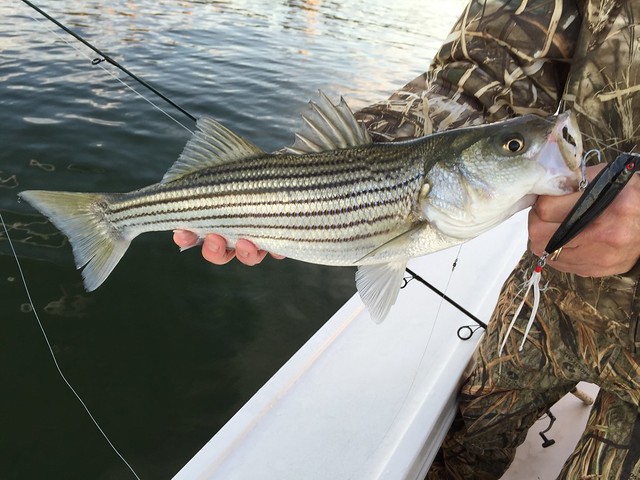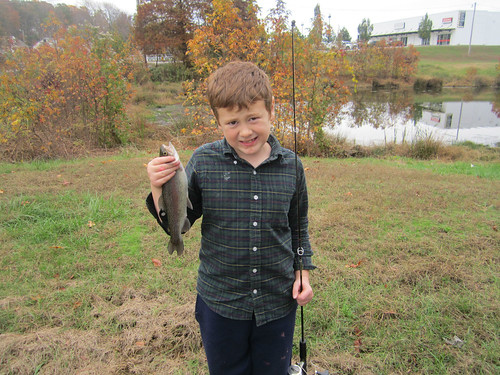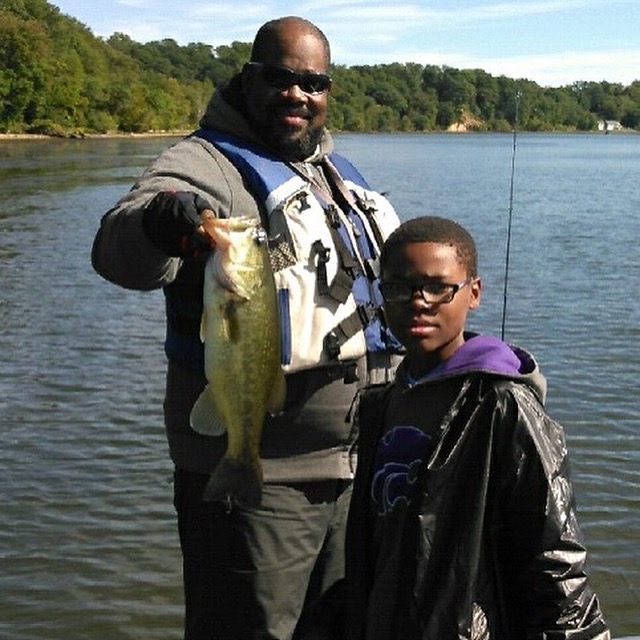By: Keith Lockwood
H.L. Mencken was one of the most influential American writers of the 1st half of the 20th century and was known as the "Sage of Baltimore". He once wrote that the Chesapeake Bay was "an immense protein factory". On this past Saturday at the mouth of the Choptank River, I felt I had been drawn into what might be best described as a huge protein feeding frenzy. Striped bass, sea gulls, baitfish and fishermen in all manner of boats ranging from large charter boats to small aluminum jon boats were all sucked into a vortex of absolute mayhem. A strong ebbing tide was pushing a variety of baitfish down the river into the masses of striped bass which in turn drew the sea gulls and finally the fishermen. The gulls dove into the surface action with total abandon as baitfish found themselves at the surface with nowhere to go. Small striped bass in the 16" size range commanded the top layer of action and larger 20" plus stripers held deeper and seemed satisfied to pick away at deeper hapless bait. Running through all of this were the fishermen. At any given time 60 to 70 boats could be seen in close proximity and the transoms of charter boats revealed ports as far away as the lower Potomac River. Most boats were trolling deep with umbrella rigs and as we vertical jigged; passing charter boats could be seen with as many as four excited anglers set into fish and mates scrambling to haul rigs and fish into the cockpit. It was an epic scene not soon to be forgotten by anyone who was lucky enough to be there. November on the Chesapeake presents some of the finest striped bass action to be found anywhere; watch the tides and make time to get out on the water and enjoy all that Maryland has to offer before winter tightens in frosty grip on what is left of the fall fishing season. If you do not have a boat or a friend with a boat, there is some good shoreline action to be found and there are many charter boats more than willing to take you and your buddies out to the action.

Photos by Keith Lockwood
The upper bay offers a lot of different fishing opportunities this week and as usual striped bass are at the top of the list for most. There are striped bass spread throughout the entire bay region and its tidal rivers. Striped bass are being caught at the very head of the bay on topwater lures in the shallows outside of the Susquehanna Flats and shorelines with good current flow such as prominent points. Water temperatures are below 60° in most areas and a little lower in the tidal rivers. Small striped bass seem to be everywhere intercepting bait on top and are mixed with larger fish at times with the larger fish often being underneath. Trolling umbrella rigs and tandem rigged bucktails along channel edges has been a good tactic when suspended fish can be located on a depth finder. This time of the year when trying to locate suspended fish a good depth finder can be one of the most important pieces of equipment on a boat. Diving sea gulls and slicks are good things to lead the way and a depth finder will confirm suspicions when looking for fish to jig over. Most are using metal jigs with single hooks or with treble hooks with barbs flattened. This really helps with releasing sub-legal striped bass quickly and reduces damage to all striped bass that are being released.
There have been good reports of striped bass action in all of the tidal rivers, Baltimore Harbor and bay locations such as Love Point and the Bay Bridge piers. White perch are schooling up near the rock piles at the Bay Bridge and many of the reefs and shoals between Baltimore Harbor and Rock Hall. Jigging with a heavy jig and dropper fly has been the most popular way to fish for white perch this fall. Using a sinker with two dropper flies is also an option, especially when fishing deep where currents are strong since it may take 3 ounces or better to get to the right depth.
The middle bay region has a lot going on this week when it comes to fishing for striped bass in the fall. Water temperatures in the bay are holding near 60° at the surface and bottom and about 3° to 4° cooler in the tidal rivers. Bay anchovies and juvenile menhaden have been the food supply that has been fueling striped bass action for several weeks out in the bay; now bait is flowing out of the tidal rivers adding to the Chesapeake Bay smorgasbord. Striped bass of all sizes are packing on winter body stores and there is hardly a time of the year that striped bass look more filled out and rich in color than now.
There are striped bass spread throughout the region and most tidal rivers have something going on. This is a time when having friends on a cell phone who will give you a call when they strike it rich with breaking fish of suitable sizes is a valuable asset. A good set of binoculars is also a good partner this time of the year. Of course action can occur on any good tide but if one was to place bets it would be on an ebbing tide at places where the current is moving at a fairly good clip. In most situations there are frisky striped bass in the 14" size range that are gobbling up any baitfish in sight on the surface. The larger fish in the 22" to 28" size range tend to be down deep close to the bottom making an ideal target for vertical jigging. In most cases 2 ounce jigs will get you to the bottom, but strong currents, water depths of 40' or more, and wind can make it hard to hold that jig straight down. Braid is a valuable asset along with a length of fluorocarbon leader. It is amazing how clear the water has been recently.
Trolling is a good option this time of the year and is a popular way to put fish into the boat when a heated cabin invites one to sit back and wait for a rod to go down. This is a very popular tactic on charter boats because it produces fish consistently. Most success is coming from trolling umbrella rigs, flat lined and with inline weights to get them down.
My fishing buddy and I talked ourselves into getting up early this past Saturday before Daylight Savings Time kicked in to see if we could still find some early morning shallow bass action. The windward shores of the lower Choptank were a bit choppy and churned up but a trip to the leeward shores provided us with water clarity to 6' or better. It was impressive to look down and be able to see individual oysters on the bottom. The fish did not disappoint us with explosive crashing strikes at our topwater lures. Water temperatures continue to drop and it is anyone's guess how much longer the shallow topwater action will last but it is worth one more try before giving in to the typical fall jigging routine.

Photo by Keith Lockwood
In the lower bay region there is scattered striped bass action throughout the region but the major part of the action is occurring in the lower Potomac and Patuxent Rivers. Jigging and trolling along channel edges has been proving to be a good local choice. The jigging is occurring when suspended fish can be located by slicks or depth finder images. Trolling has mostly centered on umbrella rigs with inline weights. The eastern side of the bay has also been producing some action with breaking fish in the lower Hooper's Island area. The very last of the bluefish tend to be at the Middle Grounds and these are truly the tail end of the 2015 bluefish. Trolling spoons and red surge tube lures behind inline weights or casting to them when they are chasing bait on the surface have been the most popular. No recent reports have come my way but chumming might be another option.
Fishing for white perch in the tidal rivers on the eastern side of the bay and also Tangier Sound continues to be a fun option for those who love their bottom fishing. Jigging with dropper flies or a simple bottom rig baited with bloodworms or clams will usually put perch in the boat. The Patuxent River has been an excellent place to catch white perch this week and the tidal rivers and creeks leading into the lower Potomac also offer good fishing for white perch. The perch are schooling up near the river mouths on deep water shoals and reefs.
Western region fisheries biologist Kenny Wampler sent us a great report of his personal fishing experiences at Deep Creek Lake for November. I would like to encourage anglers to try and get out there one last time! In recent outings during our electro-fishing surveys, as well as recent fishing outings on the lake for some fresh fish for the table, I can say that the fish are there for the taking and they are willing to eat. Fish can be found in and around the weeds at various depths on both the main lake body as well as in the backs of coves. Some techniques that have been working for me consist of night crawlers used in various ways, shiners fished under a slip bobber, jigging spoons, and the usual Rapala in various shapes sizes and colors. In my last few outings I have been able to catch a mixed bag of perch, walleye, bluegills, bass, pickerel, and pike! This is a great time of year for fishing as it can lead to some great action, and in my personal experience, this time of year is when I bring my biggest fish of the year to hand!
The last of the fall trout stocking took place last week and there are now plenty of trout in most trout management waters to provide good fishing for months to come. This is a wonderful time to get out and enjoy the fall scenery and excellent trout fishing opportunities. There are some special areas set aside for our younger anglers that have been stocked with trout. You must be under the age of 16 or blind to fish these trout stocked waters. The full list can be accessed on the trout stocking website but a few recently stocked areas are Parkview Pond in Garrett County, Lion Park Pond in Allegany County, Rising Sun Pond in Cecil County and Carroll Creek in the Frederick Community Park. Elijah Drayer got to go fishing with his dad at Hughesville Pond in Charles County and caught some stocked trout.

Photo courtesy of Elijah Drayer
Fisheries biologist John Mullican sent in a report from his recent observations on the upper Potomac River. The upper Potomac River rose about a foot from recent rains but has remained clear. Water temperatures are in the mid-50s and bass fishing has been good. Look for bass around boulders and ledges in areas with reduced current flow. Tubes, hair jigs, swimbaits, and 4" stick worms continue to entice bass. Fishing for smallmouth bass has also been good in the lower Susquehanna River and several reservoirs such as Liberty and Prettyboy and of course Deep Creek Lake. The smallmouth bass are targeting crayfish that are moving from the shallower areas where grass is declining and looking for cover in deeper waters.
Crayfish are "what's for dinner" for largemouth bass also and in many freshwater situations largemouth bass can be found in transition areas between deeper waters and the shallower areas. Grass beds are breaking up due to decreased photo periods during the day and baitfish and crayfish that found safe haven in those areas have to find new cover for the winter months. The slightly warmer deepwater areas are the place to spend the winter, tucked into some piece of cover such as sunken wood or rocks. Spinnerbaits slow rolled close to the bottom, small crankbaits, tubes, jigs and a variety of soft plastics are all good choices when fishing these transition areas.
The tidal areas of many of the rivers and creeks that feed into the Chesapeake and Potomac River offer excellent largemouth bass fishing this week. The lower water temperatures have largemouth bass, yellow perch, chain pickerel and catfish feeding aggressively in a wide variety of water depths. Ryan Johnson and his son had fun fishing for largemouth bass in the upper bay recently.

Photo courtesy of Ryan Johnson
Fishing for blue catfish remains excellent in the tidal Potomac and the larger blue cats become more active as the water temperatures cool down. This week is also a fine time to fish for channel catfish that can be found in most of the tidal rivers that feed into the Chesapeake. Fishing for northern snakeheads is also good in the creeks that feed the tidal Potomac and several river systems on the Eastern Shore. The Nanticoke and Wicomico systems have well established northern snakehead populations and they are now being found in the Choptank.
The coastal areas near Ocean City are settling into a typical fall fishery with a few anticipated arrivals on the way from up north. In the surf small bluefish and striped bass are the most common species being caught. Finger mullet is what is being used to catch the bluefish and cut bait such as menhaden for the striped bass. The southerly migration of larger striped bass will be passing the beaches of Maryland in the next couple of weeks. The southerly migration of large bluefish from up north is currently underway and most are being caught on the shoal areas close to the beaches and by those fishing for sea bass. There will be times when they hit the beaches or invade the Ocean city Inlet; I hope you are present when that event occurs.
Presently at the inlet, water temperatures are about 60°. During the evening hours small bluefish and striped bass are being caught by casting bucktails and Got Cha lures. A few are drifting live eels looking for larger striped bass. Tautog are in place at the inlet and Route 50 Bridge area. The throwback ratio is pretty high but there is plenty of action.
Farther offshore, sea bass and tautog fishing has been very good on the wreck and reef sites. Limit catches of sea bass are a common occurrence along with a mix of flounder and tautog.
Boom...Morgan
No comments:
Post a Comment